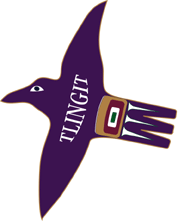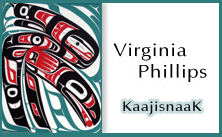
Tlingit Indians of Southeastern Alaska
Tlingit Tribe

By Virginia Phillips "Kaajisnaak"
Moiety: Raven or Eagle
Clans: Raven Dogsalmon Coho Frog Eagle Bear Wolf Killer whale
There are many more clans.
I am Tlingit, Raven, and Dogsalmon adopted by a Frog. The Raven is the smartest of all birds and the Dogsalmon is the smartest of all fish.
The correct way to introduce my self is to give my name, then say I am Tlinget, Raven, Dog Salmon and adopted by a Frog and the child of an Eagle Included in the introduction are the names of my parents, and grandparents as far back as possible and the name of the person who adopted me.
Children always are under the Tribe, Moiety, and Clan of the mother.
Thus all my children are Raven, Dogsalmon and so are the children of my daughters.
My sons children are Eagles.
Did you know that a mother passes on her mya?
DNA but the father does not pass his on to the children?
This correct way to think of yourselves and introduce your selves is:
My name is Virginia Almina Cameron Phillips.
My Tlinget name is Kaajisnaak.
My Mother was Lillian Grace Kennedy Cameron
and her Tlinget name was .......
My maternal grandmother was Mary Starish/Stash Kennedy and her Tlinget name was .....and she was from Klawock our home village.
I am Tlinget, Raven and a Dogsalmon. I am a child of an Eagle Redus Homer Cameron who was white and adopted by Jessie Walton Price The rest of you are Eagles and do the same introduction only reverse who you are and a child of.
a.) A half. A part, portion, or share.
b.) Either of two kinship groups based on unilateral descent that together make up a tribe or society. Raven / Eagle
c.) In organic chemistry, a moiety is a part of a molecule that is given a name because it is identified as a part of other molecules as well. Typically, the term is used to describe the larger and characteristic parts of organic molecules, and it should not be used to describe or name smaller functional groups of atoms that chemically react in similar ways in most molecules that contain them.
Tlingit Indians of Southeastern Alaska Class

Kahtahah Paperback – July 1, 1996
by Frances Lackey Paul (Author), Rie Muñoz (Illustrator)
This captivating true story of a Tlingit girl in Southeast Alaska in the 1800s was selected as one of the Smithsonian's Notable Books for Children for 1996.
 SHI ESTABLISHES FIRST-EVER REGISTRY OF TLINGIT CLAN CRESTS Institute publishes book about six clan crests based on knowledge from clan leaders, spokespersons; more crests to follow. Booklet: The Crests of Tlingit Clans Regular price $ 10.00 https://sealaska-heritage-store.myshopify.com/products/booklet-the-crests-of-tlingit-clans?_pos=1&_sid=3a417c4c4&_ss=r Sealaska Heritage Institute (SHI) has established the first-ever registry of Tlingit clan crests— the most important symbols of the history and identity of Tlingit people—and published a book presenting the initial six clans and crests documented for the project. The book, The Crests of Tlingit Clans, features clan narratives that were prepared from transcripts of oral histories, interviews, videos and speeches given by clan leaders and clan spokespersons representing the clans whose crests are described in the volume. The book also features imagery of the six crests, which were acquired by ancestors in the ancient past and represent crucial encounters with supernatural beings that determine the unique identity and character of clan members. The book is based on the registry, and SHI will continue to expand the resource as more crests are added, said SHI President Rosita Worl. “This initial version of the registry presents one crest for each of six clans. There are many Tlingit clans, and SHI will continue to raise funds to document additional clans and crests,” Worl said. “Furthermore, most clans have more than one crest, and the registry will also be expanded to include as many crests as can be documented.” The book includes short narratives describing the acquisition of the following crests developed from accounts provided by clan leaders and historians:
This project was supported in part through a grant from the Grants to Indian Tribes, Alaska Natives, and Native Hawaiian Organizations Program as administered by the National Park Service, Department of Interior. About Tlingit Crests Crests are the most important symbols of the history and identity of Tlingit clans, acquired by ancestors in the ancient past and representing crucial encounters with supernatural beings that determine the unique identity and character of clan members. Other significant events in clan histories are also memorialized in crests, and they may encapsulate more recent historical events that have shaped the life experiences of clan ancestors and descendants. Crests were acquired by clan ancestors and held in perpetuity by clan members through the generations as sacred clan property. The right to depict the visual representation of the encounter was often acquired as payment for the life of an ancestor, usually the ancestor who was involved in the event. The payment also bestowed on the clan an ownership claim on the crest animal or non-human being and on the place where the encounter occurred, and an exclusive relationship with the supernatural entity involved in the event. Crests embody the supernatural entities depicted on at.óow (sacred property belonging to the clan) including material objects and the stories, songs, and names which represent them. Crests are living beings and their spirits reside in at.óow, which are regarded as alive. (Excerpted from The Crests of Tlingit Clans)
|


























